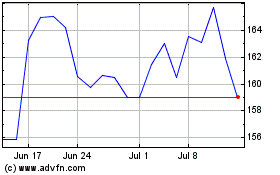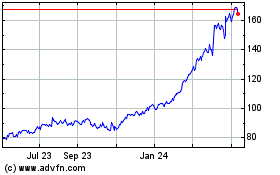At GE, Charge Leads To Loss -- WSJ
April 21 2018 - 3:02AM
Dow Jones News
By Thomas Gryta
This article is being republished as part of our daily
reproduction of WSJ.com articles that also appeared in the U.S.
print edition of The Wall Street Journal (April 21, 2018).
General Electric Co. reported a quarterly loss on a $1.5 billion
charge related to a subprime mortgage business it once owned, but
executives said they were making progress on their efforts to turn
around its industrial businesses.
GE cut $805 million of costs in its industrial businesses in the
first quarter and reaffirmed its 2018 financial targets. There were
also no major surprises for investors after a series of setbacks in
the last year. The company's power business continues to struggle,
offsetting strength in the company's jet engine and health care
divisions.
GEs battered shares rallied Friday morning, advancing 5% to
$14.70. The stock has dropped by half over the past year as the
company has embarked on a multiyear restructuring, lowered its
profit goals and cut its annual dividend by half.
On a Friday conference call, Chief Executive John Flannery said
he aims to earn back investor trust in 2018 and is "encouraged by
the progress." Nine months after taking over and launching a
strategic review, he said he continues to examine the company's
structure and promised to detail his plan in coming months.
Mr. Flannery has said all options remain on the table, including
the effective breakup of the conglomerate. He also said management
is working on a three-year strategic planning process, which it
will share with the board by the end of June.
The industrial conglomerate said Friday it expects proceeds of
$5 billion to $10 billion from asset sales during 2018. It expects
to finalize divestiture plans of its Transportation division by the
end of June and sell its Lighting business by year-end. Mr.
Flannery said GE is on track to exceed its target to cut $2 billion
in expenses this year.
The company reported a net loss of $1.18 billion for the first
quarter, including the charge for a potential settlement of a
government probe of its WMC Mortgage business. Last month, The Wall
Street Journal highlighted the risk of a charge tied to the talks
with the Justice Department over the business, a part of GE Capital
that was a large subprime lender before the financial crisis.
Excluding the charge, the company said its profits were ahead of
its plan.
Chief Financial Officer Jamie Miller said the company had
settlement discussions with the Justice Department last month. The
$1.5 billion reserve amount is based on those talks and a review of
similar settlements at other banks, she said. The reserve doesn't
change the company's plans or view in relation to GE Capital, which
it is in the process of further shrinking.
Revenue in its industrials business fell 4% in the period,
excluding acquisitions and currency swings, dragged down by
declines in its Power division, which has been struggling with
excess capacity and slack demand for its power plant equipment.
On an adjusted basis, the company reported a profit of 16 cents
a share, up from 14 cents a year ago. On that basis, analysts
polled by Thomson Reuters were expecting adjusted earnings of 11
cents a share.
Overall, GE said revenue in the March quarter rose 7% to $28.66
billion, including a boost from the merger of its Oil & Gas
business with Baker Hughes last July. GE still owns a majority
stake in the combined company. Analysts were expecting $27.45
billion in total revenue.
On Friday, GE stood by its 2018 earnings projection of $1 to
$1.07 a share. In February, the company said it was likely to meet
the lower end of that range and analysts current forecast just 95
cents a share for the year.
Revenue in the Power unit fell 9% in the first quarter and the
segment's profit fell 38%. GE said it has closed 17 sites in its
power division in the last six months and said Friday it would be
"exiting other noncore assets" in the division.
The power business is looking even worse than GE had planned,
executives said Friday, a trend it expects to see for the next few
years. The company is cutting costs but orders dropped 29% in the
quarter and it had no customers for its massive H turbine.
"The pace of the market decline is greater than the near-term
benefit of those actions," Ms. Miller said, referring to cost
cuts.
Profits and sales rose in GE's other two core units, aviation
and health care. In the Aviation business, which manufactures and
services jet engines, profits jumped 26%. With $1.6 billion in
segment profit, Aviation accounted for more profits than all of the
other units combined.
Much of investor focus and Mr. Flannery's strategy has been to
improve GE's ability to generate cash from its operations. The
company still aims for $6 billion to $7 billion in free cash flow
from its industrial operations. In the latest quarter, those
operations had negative free cash flow of $1.7 billion, compared
with negative $2.7 billion in the year ago period.
GE ended March with about in $13 billion in cash and
equivalents, down from about $19 billion in December. The company
said it still expects the end year with more than $15 billion in
cash. The cash balance excludes its GE Capital unit. The company
highlighted that it has more than $40 billion of credit lines at
various banks which are untapped.
Write to Thomas Gryta at thomas.gryta@wsj.com
(END) Dow Jones Newswires
April 21, 2018 02:47 ET (06:47 GMT)
Copyright (c) 2018 Dow Jones & Company, Inc.
GE Aerospace (NYSE:GE)
Historical Stock Chart
From Mar 2024 to Apr 2024

GE Aerospace (NYSE:GE)
Historical Stock Chart
From Apr 2023 to Apr 2024
